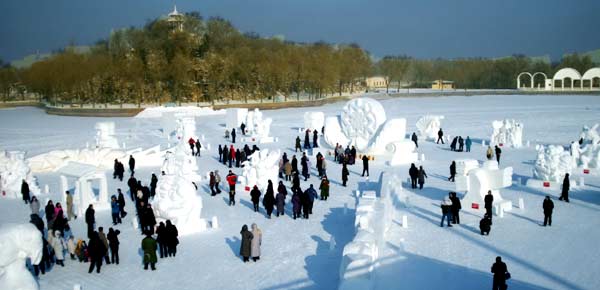Year-round charm
 |
|
A snow-carving exhibition is staged on Sun Island every winter. [Photo by Han Xin / for China Daily] |
Similar to the facelift given to Qianmen in Beijing, the two-story buildings in this network of streets in Harbin have been either demolished and rebuilt, or re-pointed and re-fitted. Authorities hope to attract big-name brands to the area, including luxury labels, while a plush hotel has already moved into one of the traditional square courtyards.

"Harbin is the 'youngest' of China's national historical and cultural cities, with only 100 years of history, but it ... contains some outstanding architecture," the publicity director says. "Comprehensive renovation of Central Street and Gogol Street, as well as the transformation of St. Sophia Cathedral and the surrounding area have added luster and beauty to this city."
The city is banking on that rich history, particularly its links to Russia.
St. Sophia Cathedral, a place of worship for Russian Orthodox Christians built in 1907, stands as a physical reminder of Harbin's colorful past in Daoli district. It fell into disrepair between 1958 and 1996, but authorities have spent large sums to restore the building's exterior, while inside an architectural art gallery boasts a collection of artifacts alongside an extensive exhibition of old photographs.
Just down the road stands another classic structure that has become a star attraction, the New Jewish Synagogue in Jingwei Street. Harbin was once home to one of the largest Jewish communities in the Far East, although today the temple is more of a museum housing artifacts from as early as the 1910s.
Harbin is not all about restoring the past, however. The city is also looking to create a better future and has invested heavily to boost entertainment and shopping options for residents and visitors alike. Arguably its most popular road, Central Street, boasts a host of clubs, bars, restaurants and many brand-name stores.
"The city's new brand (Charming Summer in Harbin) ... is the perfect fusion between man and nature, and reflects Harbin's fashion, romance, color and natural life in summer," Zhang adds.
Related: Dishing up delights, Northeast China style














